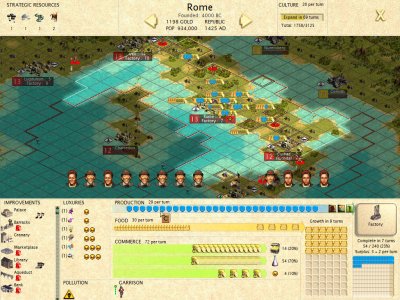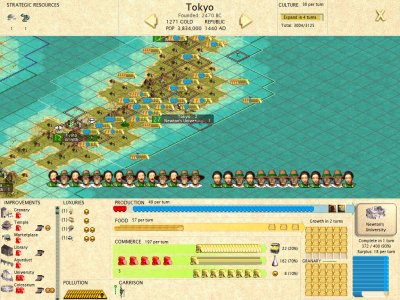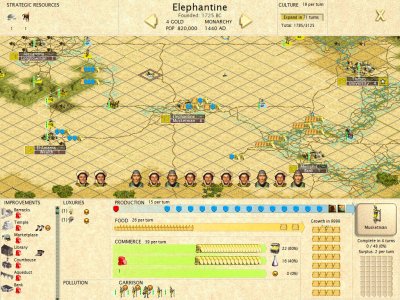During testing with the multiplayer tool to periodically switch to AI perspectives during an otherwise normal game (not debug) I noticed the following: AIs will enter lots of gpt deals with other AI civs, which causes at least two thirds of the AI civilisations in a given match to rapidly bankrupt themselves. You quickly get the tech leader swimming in 10k, 20k of money, while the others get down to 0 gold and negative gpt, causing repeated losses of buildings and units. Do you think something can be done about this?
In the same vein, do you think it'd be possible to make it so that bankrupt AIs at a negative gpt will never, ever sell a building? (Even if that means that bankruptcy entails fewer consequences for them.) With heavily perfumed granaries I see some AI cities build them five times in a single game, as they keep rebuilding it and selling it to bankruptcy. I think their economy would be much healthier if they just held on to all these buildings.
May I ask roughly how many deals and about how large a quantity? And is the money actually passed on to the recipient even if the donor has insufficient income to fund regular payments?
This would be easy. There's a method in the game whose job is to delete a building from a random city that's used on players when they go bankrupt. I could modify it to do nothing for AIs. As an aside, I wouldn't say players "sell" buildings when they're bankrupt because they receive nothing from the sale. The buildings are simply deleted. I mention it because that's something I noticed and changed for the aggressively_penalize_bankruptcy option. It makes more sense if the buildings are actually sold.
Having the option of easing conditions for the AI might help in part. Or go giving a free cheating amount of gold per city each turn, as is usually done in games, to help lose some of the incompetence in the AI economy.
I think the most important part of this is to determine what is merely a symptom and what is the cause of the problem with the AI economy. According to my observations,
AI simply doesn't know when to stop producing units it can no longer support.
Any ideas on what could be done about that?
This is probably most evident in the examples of
larger maps with isolated civilizations on islands. They have
no one to fight,
gold at 0,
buildings all sold off and the ones that are built are sold off immediately as well, but because they are
able to build more units each turn than they lose via disbanding due to the cost of sustaining units, they are literally in an endless loop that is very hard to get out of. The fate of such backward civilizations is usually that a far more advanced civilization comes along with whom they come into conflict, and the more advanced civilization decimates all of their offensive forces, which
ironically revives the economy of the backward civilization. Sometimes the situation is so extreme that a civilization is unable to even maintain workers and therefore has not built proper roads, so its economic capacity is completely lost. This is just an example where multiple things affecting this complex problem go wrong, because of course there are isolated island civilizations that manage to avoid this fate.
To be fair, perhaps this behavior is perfectly justified because it's part of some triggering process that outsiders can't see into and without which the AI would be unable to plan its war campaigns. Perhaps there are situations where unregulated troop production is appropriate regardless of sustainability or economic consequences especially in times of war or preparation for war. Perhaps the problem would be that some government regimes do not have large enough troop support for even basic city defense units.
Still, I think a new rule (if one doesn't already exist) is needed to limit unsustainable military production in situations like:
-
I have no contact with any other civilization. (I'm isolated on an island by myself.)
-
I'm hopelessly technologically backward. (Something needs to change instead of making basic archers over and over again essentially until the end of the game.)
-
I am the strongest of all the civilizations I know of. (The Military Advisor knows when comparing to another civilization whether our military is
weak,
average, or
strong, so for both average and strong cases, there could be a limitation on continued troop production depending on the aggressiveness of the civilization.)
Perhaps the simplest solution would be to have a
Ratio (like for artillery or bombers)
between Units and Buildings (including wealth) being built in cities at the same time. When approaching the limit of supported units given by the government regime to more than 80%, the ratio would start to apply and cities would be forced to switch production from units to buildings either
immediately or
after the current production is complete.
The encouragement only applies if the AI is already above a minimum of 1 defensive unit per city and 1 offensive unit per 2 cities. The exception would be cities with no defenders, because it would be foolish for such defenseless cities to be forced to build a building. Another exception could be situations where the AI is panicking because it has an enemy outside the city gates. If this could really be worked out
in detail, there would be multiple levels of this ratio depending on the aggression level and the limit of units supported by a given government regime:
(Units / Supported Units = X%)
Aggression Level: 0
80% - ai_build_unit_ratio = 50,
90% - ai_build_unit_ratio = 30,
100% - ai_build_unit_ratio = 15,
110% - ai_build_unit_ratio = 5,
120% - ai_build_unit_ratio = 2,
150% - ai_build_unit_ratio = 1.
Aggression Level: 1
80% - ai_build_unit_ratio = 60,
90% - ai_build_unit_ratio = 40,
100% - ai_build_unit_ratio = 20,
110% - ai_build_unit_ratio = 10,
120% - ai_build_unit_ratio = 3,
150% - ai_build_unit_ratio = 1.
Aggression Level: 2
80% - ai_build_unit_ratio = 75,
90% - ai_build_unit_ratio = 50,
100% - ai_build_unit_ratio = 25,
110% - ai_build_unit_ratio = 15,
120% - ai_build_unit_ratio = 5,
150% - ai_build_unit_ratio = 2.
Aggression Level: 3
80% - ai_build_unit_ratio = 90,
90% - ai_build_unit_ratio = 75,
100% - ai_build_unit_ratio = 50,
110% - ai_build_unit_ratio = 25,
120% - ai_build_unit_ratio = 10,
150% - ai_build_unit_ratio = 5.
Aggression Level: 4
80% - ai_build_unit_ratio = 100,
90% - ai_build_unit_ratio = 80,
100% - ai_build_unit_ratio = 60,
110% - ai_build_unit_ratio = 40,
120% - ai_build_unit_ratio = 20,
150% - ai_build_unit_ratio = 10.
@SG52 I appreciate the passion. I can be quite verbose myself, but you might kill Flintlock with your tomes.
You kind of expect to run into people on the forums for a game celebrating its 24th birthday this year who aren't exactly normal and have a certain unusual passion for the cause. All I care about is pitching ideas that might interest someone enough to implement them. You never know which seemingly banal idea will turn out to be literally game-changing in terms of enjoyment of the game or quality of the experience. The very least that is expected of me is to express myself in the most organised way possible, so that it is clear that I have thought through the issue to its implications and as comprehensively as possible. Things that until recently seemed unthinkable are now within reach and one becomes curious as to how far it is possible to go. What a time to be alive and be a fan!

 The game is already so far beyond what was possible pre-C3X.
The game is already so far beyond what was possible pre-C3X.

